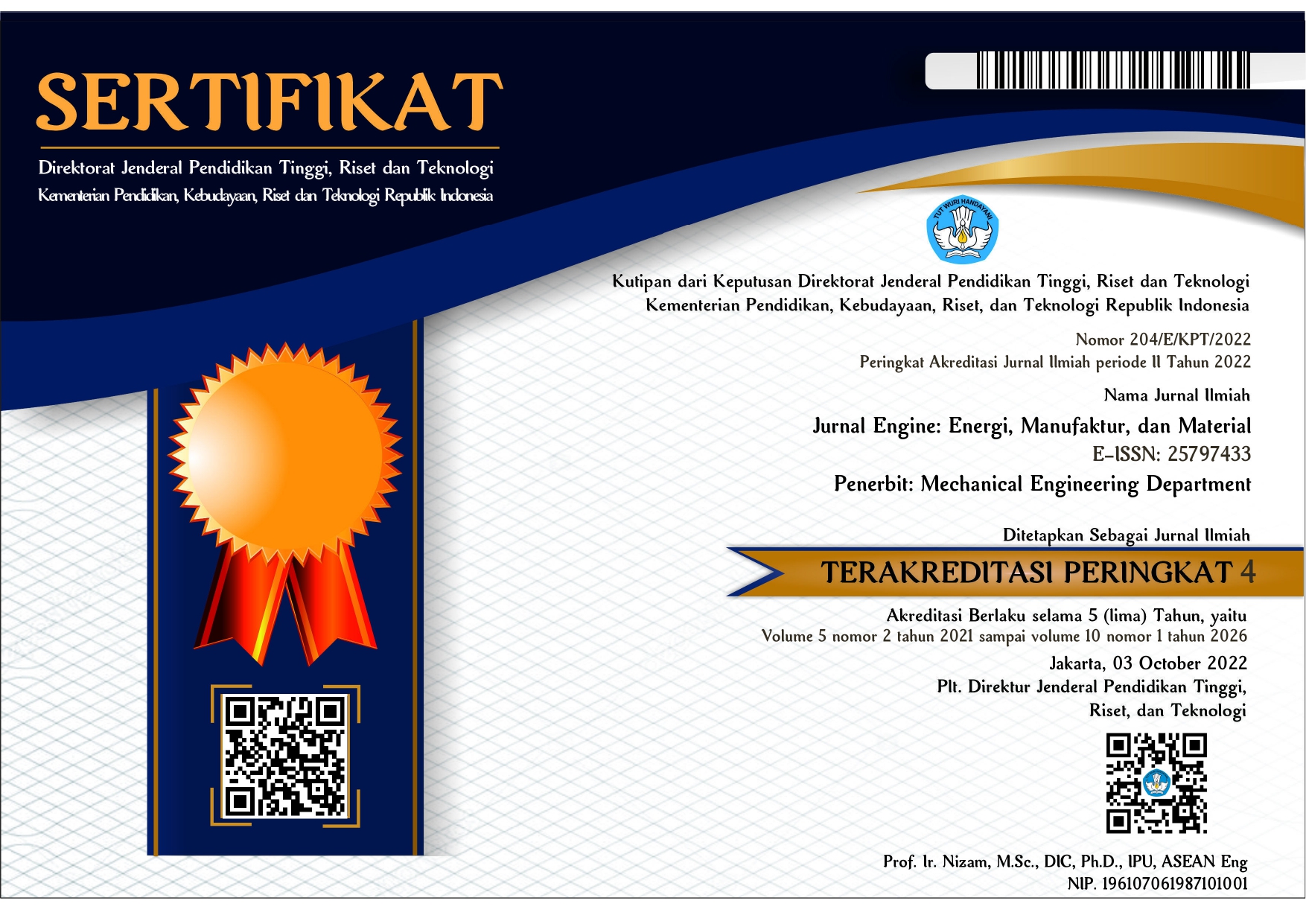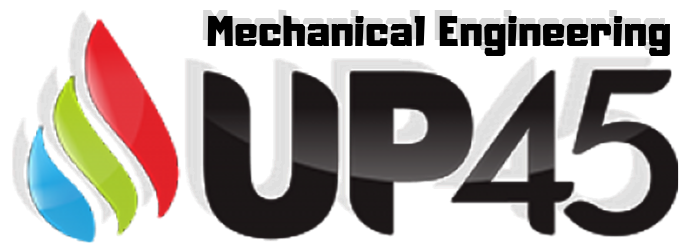Analisis Laju Aliran Udara dan Laju Aliran Massa Bahan Bakar Terhadap Beban Pembakaran Sampah pada Incinerator Berbahan Bakar Limbah Oli Bekas
DOI:
https://doi.org/10.30588/jeemm.v5i1.838Keywords:
Waste, incinerator, burner furnanceAbstract
The amount of household waste and B3 from oil machine waste have been increasing along with the increasing of polulation and the number of vehicles. This waste can be used as a source of energy. The aim of this research was to analize the air flow rate and mass flow rate of fuel in the incinerator oil machine waste using a burner furnace by conducting several variations of the experiment with variations in air velocity of 10,4 m/s (B1), 13,4 m/s (B2) and 14,3 m/s (B3) and fuel flow rate of 0,00408 l/s (A1) and 0,00838 l/s (A2) with fuel valve openings 1/2 and 1/4. The test results showed that the highest temperature was 1021,50C in the A2-B3 experiment with 45 minutes and the lowest temperature was obtained in the A1-B1 experiment which was 840,50C at the same time. In the incinerator test, the burning of dry plastic waste weighing 12 kg of waste burns out in 34 minutes with a temperature ratio for the burner furnace which is 780,90C and the incinerator chamber space is 480,70C and the combustion rate is 21,42 kg/hour. the yield of residual combustion is 9,32% and the incinerator combustion eficiency is 90,68% and for dry leaf waste weighing 8 kg the waste is burnt out in 20 minutes with a burner furnace temperature ratio of 712,30C and incinerator chamber space of 443, 20C and the combustion rate of 24,24 kg / hour and the yield of combustion residue is 96,94%.References
Ardi, P. D. (2017). Pengujian Alat Incinerator Untuk Pengolahan Limbah Padat Rumah Sakit Tanpa Menggunakan Bahan Bakar Minyak Dan Gas. Yogyakarta: Jurusan Teknik Mesin Muhamadiyah Yogyakarta.
Budiman, A. (2001). Modifikasi Desain dan Uji Unjuk Kerja Alat Pembakar Sampah (Incinerator) Tipe Batch. Bandung: Scientific Repository Faculty of Argicultural Technology.
Jamaluddin. (2016, January 12). Balai Besar Pelatihan Pertanian. Retrieved from Jangan Membakar Sampah: www.BBPP-Batangkaluku.com
Kurdi, M. Y. (2017). Depok Bebas Sampah. Retrieved Maret Selasa, 2020, from https://depokbebassampah.wordpress.com/acuan/incenerator/
Latief, A. S. (2010). Manfaat dan Dampak Penggunaan Insinerator Terhadap Lingkungan. Jurnal Tenik Mesin Politeknik Negri Semarang, 5(1), 20.
Lolo, D. P. (2014). Analisis Penggunaan Incinerator Pada Pengolahan Sampah Di Kota Merauke. Jurnal Teknik MUSTEK ANIM HA VOL 3, 200-211.
Margono, & Rahardjo, H. P. (2011). Rancang Bangun Prototipe Tungku Pembakar Sampah Radioaktif. Jurnal Perangkat Nuklir Vol 5, 1-8.
Nurhayati, N. (2013). Pencemaran Lingkungan. Bandung: Yrama Widya.
Raharjo, W. P. (2009). Pemanfaatan Oli Bekas Dengan Pencampuran Minyak Tanah Sebagai Bahan Bakar Pada Automizing Burner. Publikasi Ilmiah, 10(2), 2.
Ratman, C. R., & Syafrudin. (2007). Penerapan Pengelolaan Limbah B3 Di PT. Toyota Motor Manufacturing Indonesia. Jurnal Presipitasi Vol 7, 62-70.
Subagiyo, E. N., Santoso, S., & Irawan, B. (2015). Potensi Energi Sampah Rumah Tangga Hasil Pembakaran Insenerator Sistem Kontinyu. Jurnal Teknik Mesin dan Kimia Vol 16, 2.
Suharto, Hariyanto, Satito, A., Pratomo, A. W., & Tritijanto, H. (2012). Modifikasi Burner Berbahan Bakar Limbah Oli Bekas dengan Metode Pre-Heating Untuk Aplikasi Pengecoran Kuningan. Semarang: Politeknik Negri Semarang.
Sumingkrat, & Yusuf, A. (2014). Penogolahan Limbah Cair Dengan Limbah Padat Abu Hasil Pembakaran Incinerator Klor Alkali. Jurnal Teknologi Dan Manajemen Vol 12 No 1.
Supriyanto, B. (2007). Pengaruh Kecepatan Udara Terhadap Pembakaran Oli Bekas Menggunakan Automizing Burner Untuk Peleburan Alumunium. Surakarta: Skripsi S1 Teknik Mesin FT UNS.
Widhiasto, R. (2010). Pengaruh Tekanan Udara Terhadap Sifat Pembakaran Minyak Jelantah Menggunakan Vaporizing Burner Untuk Peleburan Alumunium. Surakarta: Skripsi S1 Teknik Mesin Universitas Sebelas Maret Surakarta.
Downloads
Published
How to Cite
Issue
Section
License
Authors who publish with Jurnal Engine: Energi, Manufaktur, dan Material agree to the following terms:
Authors retain copyright and grant the Jurnal Engine: Energi, Manufaktur, dan Material right of first publication with the work simultaneously licensed under a Creative Commons Attribution 4.0 International License that allows others to share (copy and redistribute the material in any medium or format) and adapt (remix, transform, and build upon the material) the work for any purpose, even commercially with an acknowledgment of the work's authorship and initial publication in Jurnal Engine: Energi, Manufaktur, dan Material. Authors are able to enter into separate, additional contractual arrangements for the non-exclusive distribution of the journal's published version of the work (e.g., post it to an institutional repository or publish it in a book), with an acknowledgment of its initial publication in Jurnal Engine: Energi, Manufaktur, dan Material. Authors are permitted and encouraged to post their work online (e.g., in institutional repositories or on their website) prior to and during the submission process, as it can lead to productive exchanges, as well as earlier and greater citation of published work (See The Effect of Open Access).


















